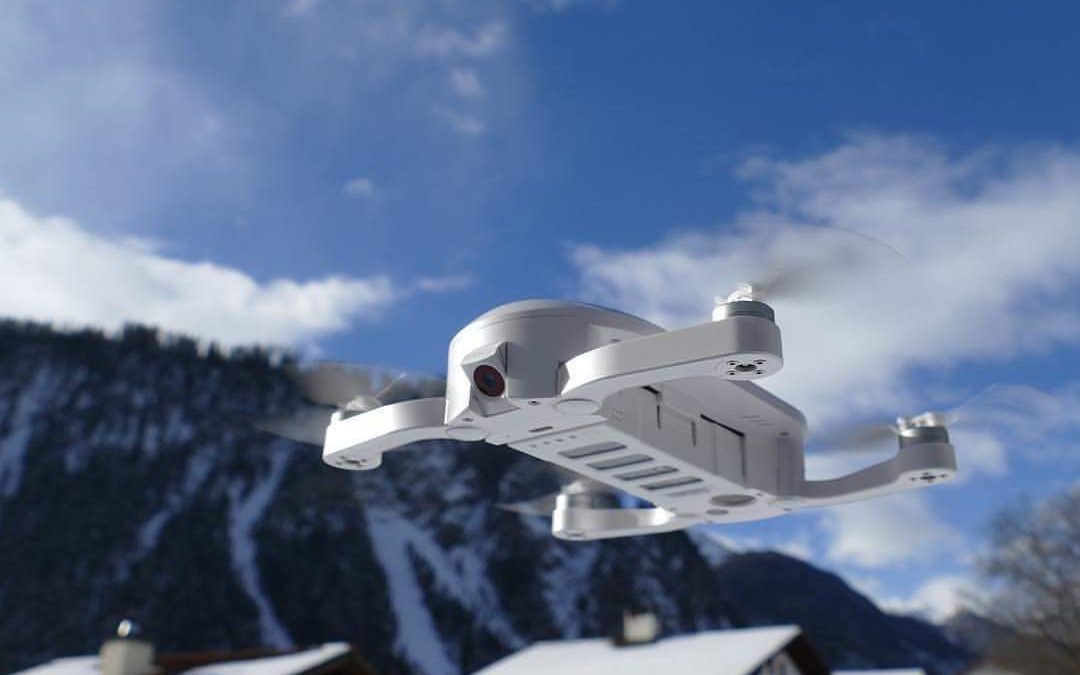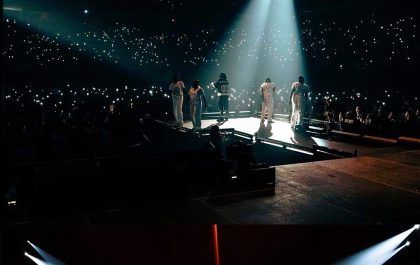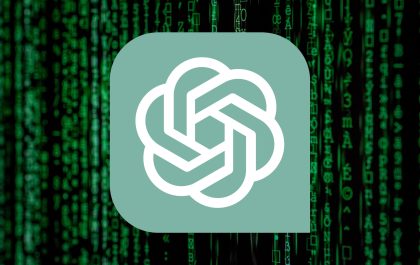Drones are tackling everything from disease control to vacuuming up ocean waste to delivering pizza, and more.
Drone technology has been used by defense organizations and tech-savvy consumers for quite some time. However, the benefits of this technology extends well beyond just these sectors.
With the rising accessibility of drones, many of the most dangerous and high-paying jobs within the commercial sector are ripe for displacement by drone technology. The use cases for safe, cost-effective solutions range from data collection to delivery. And as autonomy and collision-avoidance technologies improve, so too will drones’ ability to perform increasingly complex tasks.
The emerging global market for business services using drones is valued at over $127B, according to PwC. And as more corporations look to capitalize on these commercial opportunities, investment into the drone space has grown.
A drone or a UAV (unmanned aerial vehicle) typically refers to a pilotless aircraft that operates through a combination of technologies, including computer vision, artificial intelligence, object avoidance tech, and others. But drones can also be ground or sea vehicles that operate autonomously.
Below, we look at the ways that a wide range of companies are harnessing drone technology for commercial purposes across industries.
1. Defense While military drones have been used for over a decade (the Predator UAV is among the most well known), smaller, portable drones are now being used by ground forces on a regular basis.
Military spending for this technology is expected to grow as an overall percentage of military budgets, providing an opportunity for specialized drone manufacturers and software developers.Since 2014, US military spending on drone technology has increased from just over $4B to about $9B annually, according to the Center for the Study of the Drone at Bard College. It estimates that 95 countries around the world already possess some form of military drone technology, up from just 60 about 10 years ago.
Many of the drones are being designed exclusively for surveillance, but others for offensive operations. Prox Dynamics, a military grade UAV manufacturer acquired by FLIR Systems in Q4’16, offers one of the many reconnaissance UAVs used by militaries around the world, including the US Marines, the British Army, the Australian Army, and Norway’s Armed Forces.
In addition to the use of new aerial technologies, militaries continue to use unmanned ground vehicles, or UGVs, to lead tactical initiatives. Startup Clearpath Robotics manufactures both UAVs and unmanned ground vehicles UGVs and lists the US Department of Defense, the US Army, and the US Navy as clients.
2. Emergency Response Innovations in camera technology have had a significant impact on the growing use of drones. UAVs outfitted with thermal imaging cameras have provided emergency response teams with an ideal solution for identifying victims who are difficult to spot with the naked eye.
In 2017, Land Rover partnered with the Austrian Red Cross to design a special operations vehicle with a roof-mounted, thermal imaging drone. The vehicle includes an integrated landing system, which allows the drone to securely land atop the vehicle while in motion. This custom Land Rover Discovery, dubbed “Project Hero,” hopes to save lives by speeding up response times.
Last year, drone manufacturer DJI launched an emergency response program that gives first responders access to some of the company’s drones and peripherals, as well as technical support and assistance. So far, DJI has partnered with fire departments in Los Angeles and Menlo Park, plus the Alameda County Sheriff’s Office.
Startup companies and universities are also designing systems intended for search and rescue. Flyability offers a collision-tolerant UAV designed to function in confined areas with limited lines of sight — environments often encountered by emergency response teams.
Additionally, Delft University of Technology has tested an ambulance drone that could deliver defibrillators on demand. By extending existing emergency infrastructure, drones may be able to dramatically increase survival rates in both rural and urban areas around the world.
3. Humanitarian Aid & Disaster Relief In addition to emergency response, drones have proved useful during times of natural disaster. In the aftermath of hurricanes and earthquakes, UAVs have been used to assess damage, locate victims, and deliver aid. And in certain circumstances, they are helping to prevent disasters altogether.
In 2017, drones were used to help restore power to areas damaged by Hurricane Harvey, as well as survey damage to flooded areas and assist in search and rescue efforts.
To help monitor and combat forest fires, surveillance drones outfitted with thermal imaging cameras are being deployed to detect abnormal forest temperatures. By doing so, teams are able to identify areas most prone to forest fires or identify fires just minutes after they begin.
Demand for this kind of technology is growing. In 2019, the Department of Defense made an official request for drones that can be deployed during a natural disaster to distribute food and water to affected areas.
4. Conservation Poaching and climate change have a dramatic impact on the health of wildlife worldwide. Thousands of species are estimated to go extinct each year, according to the World Wildlife Fund. To help combat this trend, conservationists are adopting innovative methods to protect and study our global ecosystems. In combination with geospatial imagery, drones are now used to monitor and track animals.
A team at Liverpool John Moores University’s School of Natural Sciences is building an autonomous drone system that can follow endangered species and transmit information about their well-being back to researchers.
DJI has worked within the conservation space, offering drone services to help teams to conduct research without disturbing natural habitats. The Ocean Alliance is an example of an organization that has used drones (such as the marine SnotBot) to collect samples — specifically, mucus from whales. In addition to facilitating research on ecosystems, drones can also allow conservationists to combat poachers.
5. Disease Control Tracking animals also allows researchers to track disease. Drones with thermal imaging cameras have been used by the London School of Hygiene and Tropical Medicine to track macaque movements in the province of Palawan in the Philippines — a region where malaria is an active threat.
The ability to follow these animals provided further insight into the possible movement of infectious disease and its jumps from animals to humans. In a similar vein, Microsoft is leveraging drone technology to capture and test mosquitoes for infectious disease. Ideally, this intelligence could be used to protect local residents, and in the future could help prevent epidemics before they begin.
Another illness being combated with the help of drones is schistosomiasis, a tropical disease caused by parasitic worms. A team of researchers made up of scientists from the University of Washington and Stanford pioneered an experimental method for tracking the spread of and predicting transmissions of schistosomiasis. Instead of using animals, the team’s approach uses drone and satellite imagery to track the presence of “unrooted, floating vegetation” where the snails that transmit the disease make their habitats — finding these sites through drone imagery lets those researchers know what areas are at higher risk for schistosomiasis infections.
6. Healthcare Modern medicine has had a profound impact on preventing disease, increasing life expectancy, and raising general standards of living. However, many rural regions around the world lack access to high quality healthcare. While medical supplies can be delivered by traditional means, certain circumstances call for quick access to drugs, blood, and medical technology — a need drones could fulfill.
In 2018, WakeMed Health & Hospital in North Carolina partnered with the state’s department of transportation on a pilot program to test out the practicality of using to drones to deliver medical packages between hospital campuses.
After a series of successful tests, WakeMed formed a partnership with the California-based drone manufacturer Matternet and later with UPS to further develop the hospital’s drone delivery efforts.
One well-funded venture-backed medical delivery company is Zipline International. Zipline, which has raised $237M in total disclosed funding, offers delivery drones in rural areas throughout Africa. Flirtey is another startup in the delivery space that is looking to transport medicine.
7. Agriculture Farmers across the world are continuously striving to reduce costs and expand yields.
With the use of drones, agricultural workers are able to gather data, automate redundant processes, and improve efficiency.
Raptor Maps, for example, is an agricultural analytics startup that relies on drones to help farmers better predict their potential harvest.
Another area where drones are gaining traction is the cultivation of crops— a process that can be repetitive, time-consuming, and detail oriented. To help address this, equipment manufacturer Case IH has built an autonomous tractor, while Abundant Robotics is developing a solution for autonomously picking produce. Planting seeds can be an equally energy-intensive process, but companies like DroneSeed, which raised $5.1M from Social Capital in 2017, are looking to make the task easier by using drones for airborne seed dispersal.
In a research capacity, drones have also been used to pollinate flowers. This approach could one day prove helpful in compensating for the declining bee population.
8. Weather Forecasting Scientists are leveraging new forms of hardware and software for data collection to help study the climate and better predict future changes to global weather systems. Today, most data is collected through stationary structures or captured with geospatial imaging solutions. Drones, however, offer a versatile option that can physically follow weather patterns as they develop.
In addition to aerial vehicles, water-based unmanned surface vehicles (USVs) are changing the way data is gathered. Saildrone has developed an autonomous sailboat that collects oceanic and atmospheric data from the ocean surface.
A Saildrones pilot project, being run in collaboration with the University of Washington Atmospheric Scientists, is now active off the West Coast near the Bay Area. As part of the research, 6 of the company’s drones are autonomously collecting data off the shore. The scientists behind the project hope that the data collected by the drones will help make weather forecasts more accurate.
9. Maritime Navigating oceans and ports requires an immense amount of expertise and labor from the estimated 1.65M people serving on international merchant ships today. But with increasing amounts of oceanic data and innovations in autonomy, unmanned marine vehicles could become the standard for maritime shipping. Rolls-Royce has already completed a number of trials with unmanned vessels controlled remotely.
Inspecting ships is also an important part of the industry. While Rolls-Royce plans to use smaller UAVs to help inspect ships above the surface, startup Orobotix has designed an underwater drone used to inspect hulls from below.
Drones are already being used in countries like the Netherlands, Denmark, and Norway to find ships committing emissions infractions. The unmanned vehicles can travel miles out from port to detect emissions and identify offenders.
10. Waste Management Recycling and biodegradation have improved global waste management. However, innovations in waste collection are still emerging, including drones that have help to clean oceans. RanMarine operates a Roomba-like unmanned marine vehicle used to collect waste in ports and harbors, while RedZone Robotics focuses on robots used to help maintain systems for wastewater management.
11. Energy While alternative energy has become increasingly popular, fossil fuels still remain a key energy source for the world. Inspection of the infrastructure used to extract, refine, and transport oil and gas is an important part of the industry and often needed to ensure compliance with regulations and standards.
With the use of drones, much of this inspection work can be done remotely and safely. Using specialized thermal sensors, some drones can find leaks faster than a human inspector, while onboard high-resolution cameras enable some issues to be diagnosed remotely. Sky-Futures offers UAVs for oil and gas inspection, and is used by many of the world’s largest oil companies to inspect offshore rigs. The company was acquired by Scotland-based maintenance company ICR in 2019. SkyX Systems uses drones for pipeline assessment, while Cyberhawk Innovations offers solutions for both fossil fuel and alternative energy providers.
Another area where drones have shown promise is in setting up new sites for the production of energy. Drones that survey areas and gather topographic detail can be used to help oil & gas companies identify new drill sites, or they can be used by solar utilities to design configurations for new arrays.
12. Mining Mining is a capital-intensive venture that requires constant measurement and assessment of physical material. Stockpiles of ore or rock or minerals are difficult to measure. But with unique cameras, drones are able to capture volumetric data on stockpiles and survey mining operations from the air. This reduces the risks associated with having surveyors on the ground.
Airobotics, which has raised more than $90M in disclosed equity funding, provides an industrial grade on-site drone solution used by mining companies for measuring materials, surveying operations, and boosting security. The system is fully autonomous and stored in on-site housing that can autonomically swap cameras and batteries.
Mining is also being disrupted by autonomous vehicles, such as the unmanned ground vehicle designed by Komatsu.
13. Construction Planning One of the most common commercial use cases for drones is construction planning and management. Software developers have created solutions that analyze construction progress with regularly captured data. While ground surveying is still a critical part of construction planning and monitoring, the use of drone data has become increasingly important.
Camera technology is used to monitor buildings and gauge topography and soil type throughout the construction lifecycle. Skycatch offers these services in a monthly software subscription that is designed to pair with a number of UAVs. Dronomy offers a similar suite of software intended to help drones enhance project monitoring and site management.
14. Infrastructure Development While drones serve a useful purpose in construction planning and management, they also have the potential to be used to develop physical infrastructure.
ETH Zürich, a prominent university in Switzerland, partnered with roboticist Raffaello D’Andrea and architecture firm Gramazio Kohler Architects to create a structure built entirely by UAVs.
By programming the drones to lift and stack thousands of polymer bricks, the team was able to create a geometric structure nearly 10 meters high. The finished product serves as a concept for a “vertical village” that would employ a similar structure, which would be built by larger drones.
The Minnesota Department of Transportation began studying the potential of drones to make the department’s work more efficient in 2015, and found that using drones for inspections of state infrastructure helped the state save about 40% on associated costs.
By 2018, around 80% of state departments of transportation were utilizing drones, according to a survey conducted by the American Association of State Highway and Transportation Officials. Uses include monitoring the progress of highway construction projects, surveying new sites, inspecting bridges, emergency response, and more.
15. Insurance Insurance inspections are a core area where insurance companies can leverage drones. Traditionally, inspectors and assessors for property insurance would scale structures to conduct manual inspections of properties, but now drones can provide detailed assessments with high-resolution cameras.
While damaged or defective property still requires the attention of a physical inspection, UAVs are beginning to have an impact there as well.
Drone companies focused on the insurance industry include Kespry, which offers services like roof inspection for claims and has partnered with Farmers Insurance to scale its offerings in the insurance space.
16. Realty Drones have been beneficial in capturing pictures of high-value properties, showing that even the real estate industry can be upended by drone technology. By 2016, real estate was already reported to be one of the most active industries when it came to adopting drone technology.
DroneBase is one company that offers on-demand drone photography for a number of different industries, including residential and commercial real estate.
While low-cost aerial photography is being leveraged to take images of a property’s exterior, home interiors are also being captured by small, agile UAVs. Zaw Studios, a media company based outside of Los Angeles, uses drones to capture immersive 360-degree photographs and videos within large homes. The finished product provides potential buyers with a perspective that mimics a physical walk-through.
For property developers, drones can be a useful tool for understanding how to better outfit a property with the views, amenities, and features. Being able to quickly scan a property from all angles can allow a better ability to design a structure for the landscape in which it sits.
17. Urban Planning As urbanization continues, cities are having to adapt to larger populations and chronic congestion. Urban planning has become increasingly important for cities, but requires a thorough understanding of metropolitan rhythms and flows. With the use of drones, urban planners are able to better understand their environments and implement data-driven improvements.
Engineering consulting firm Arup has used drones to gather data in population-dense areas. With many municipalities operating on limited budgets, drones can provide a relatively low-cost way to capture invaluable urban data. For example, drones have helped city planners determine which areas may benefit from green space.
Today, machine learning is helping make more sophisticated mapping processes possible at a lower cost. In Benin, the Benin Flying Lab used drones to create a data-dense aerial map of the town of Dassa, then applied machine learning technology to classify the different types of structures and regions on the map, a process that would have taken a significant amount of time and labor without the software.
18. Personal Transportation While our definition of drones is typically limited to unmanned vehicles, certain emerging forms of autonomous transportation function similarly to drones. For example, China-based EHANG, which went public last year, built an autonomous aerial vehicle (AAV) that operates with 4 rotors (quadcopter) for vertical takeoff. The vehicle is intended to transport passengers between destinations, even in an urban environment with plenty of obstacles. The AAV requires minimal passenger input and incorporates built-in systems that aim to allow safe landings in the event of engine failure or a collision.
Lilium Aviation, meanwhile, is a startup looking to build an autonomous aerial vehicle for passenger transportation that leverages a design more comparable to a Harrier Jet than a typical drone.
Incumbents are also making moves in the space. Uber, Airbus, Boeing, and Rolls-Royce are 4 of the big transportation companies working on developing their own autonomous flying drones for ferrying passengers around.
In preparation for a world of drone-like robotaxis, investors around the world are already buying up sites with the acreage and air rights necessary to serve as potential “vertiports” — places for AAVs to land — a lack of which could slow the proliferation of these vehicles around the world.
19. Airlines Compliance is a challenge for many industries, but the airline industry must adhere to particularly stringent levels of regulatory standards. FAA inspections vary in comprehensiveness, but basic inspections are conducted after every 125 hours of flight time. Additionally, airlines are expected to conduct their own routine inspections before every flight.
In an attempt to improve this process, Intel partnered with Airbus to conduct exterior aircraft inspections with UAVs. Intel supplied drones outfitted with cameras that allow them to collect images and data that can be used to create detailed, 3D-models of the Airbus fleet.
Airbus has also launched its own drone subsidiary called Airbus Aerial, which looks to provide inspection services across a variety of industries. Canard Drones, meanwhile, is a startup looking to provide inspection solutions for airports rather than aircraft.
20. Telecommunications Telecommunication towers also are inspected frequently to ensure service reliability. In the aftermath of Hurricane Harvey in 2017, AT&T and Verizon launched drones in Houston, Texas to inspect their towers — a process that would have been too dangerous and time-consuming to do manually. These drones were able to quickly assess damage to help guide repair teams in restoring service. In many cases, service was brought back in hours rather than days.
Skyward, an inspection drone company purchased by Verizon in Q1’17, provides a drone-as-a-service software platform that helps commercial drone operators in a variety of industries.
21. Internet With the world’s largest tech firms vying for our time and attention, the need for global internet access is becoming more and more central to business models.
Facebook experimented with a solar-powered drone called Aquila, which was envisioned as helping to provide internet access to rural parts of the world. The Aquila drone was touted as a core component of Facebook’s push to increase internet access around the world before work on it was halted in mid-2018 when the social media giant decided to use third-party drones instead.
Google initially acquired solar-powered drone company Titan Aerospace to provide UAV-powered internet (similar to Aquila), but the venture proved challenging. It has since pivoted toward a weather balloon-like design called Project Loon that aims to provide internet access from the stratosphere.
SoftBank, in collaboration with the drone manufacturer AeroVironment, has its own plans to develop drones that will operate in the stratosphere to serve as “floating cell towers” to provide internet service to customers.
22. Outdoors In the consumer area, an early application for drones was as a recreational tool for the great outdoors. Between aerial landscape photography and extreme sports footage, UAVs changed the way people experienced locations.
Today, drones are being used for more than breathtaking photos and award-winning film. SenseFly, acquired by France-based drone company Parrot in Q3’12, has had its drones used to create a 3D rendering of the infamous Matterhorn peak in Zermatt, Switzerland. Drones were able to map the entire mountain face in less than 7 hours. These types of models can be used by climbers and skiers to better understand the terrain.
23. Tourism & Hospitality Not only have drones transformed the way hotels conduct marketing, but they may also transform our notion of luxury accommodations. Design firm HOK envisions drone hotels that can travel to new locations on demand. These modern structures could fly to remote and traditionally inaccessible locations for guests.
Traditional hotels are also adopting drones, such as those offered by Unsupervised AI, which uses drones to deliver packages and room service quickly and autonomously.
The Marriott Marquis Chicago, on the other hand, used drones to deliver cocktails to the guests at its grand opening in 2017. Working with drone company DJI, Marriott has also tested using drones to provide guests with entertainment at the JW Marriott Zhejiang Anji Resort in China.
24. Live Entertainment Drones have already had an impact on event surveillance and event photography/film, but are also being used more directly to entertain. Disney has been one of the more active companies in this space, and has filed for a number of drone patents focused on entertainment. Synchronized lights shows, floating projection screens, and drone puppeteers have all been considered by the entertainment giant. Verge Aero is one example of a private player creating live, synchronized drone performances for audiences.
At Universal Studios’ new Wizarding World of Harry Potter exhibit, a show composed of LED-lit drones and complex projections caps off the “Dark Arts at Hogwarts Castle” show. Utilizing Intel’s Shooting Star technology — which was also used during the 2019 Super Bowl halftime show and during the 2018 Winter Olympics — the drones can be programmed to reflect a number of patterns and synchronize with music and other elements of the live performance.
25. Sports Skycam, a robotic camera suspended from a cable-driven, computerized transport system, changed the way viewers experience televised sports. The camera provides up-close and personal perspectives that traditional, stationary cameras cannot capture. Today, Skycam is a necessity for any professional arena sports broadcast.
Drones, however, are becoming increasingly popular for professional sports outside of the stadium. Vermeer, for example, offers live sports broadcast services that have been used in a number of live and recorded TV broadcasts.
In addition to traditional sports, drones are influencing sports of their own. The Drone Racing League, for example, is a global drone-racing series.
26. Hollywood One of the first industries to adopt drones was professional film. Drones have allowed filmmakers to capture dramatic aerial perspectives without the use of helicopters. This has had a dramatic impact on Hollywood’s bottom line, pushing the limits of cinematography.
As the adoption of this technology has grown, the Federal Aviation Administration and the Motion Picture Association of America have worked together to establish procedures for regulating commercial drone use within the space.
Aerial MOB, acquired by 5D Robotics in Q2’16, has used drones to film content for movies like The Circle, Guardians of the Galaxy, and La La Land, among others. It has also used drones to film a variety of advertisements.
The XM2 Cine Sierra, with a maximum payload of 65 pounds, is one of the largest drones designed specifically for cinematography. It has found wide use on big-budget Hollywood pictures, including films like Star Wars Episode IX.
Work is also ongoing to develop drones that can film without the need for an active human guide. Researchers at Carnegie Mellon University are experimenting with autonomous drone software that aims to allow a drone to independently stay afloat, follow a human figure through a complex environment, and execute various blocking and tracking directions.
27. Advertising In addition to filming advertisements, drones are being used as physical mediums for marketing. They can power aerial advertising at live events or high traffic locations. DroneCast, for example, has developed services for banner advertising and has delivered Ford-branded knickknacks to patrons at auto conventions.
28. Retail Drones are being used to deliver goods from local retailers and fulfillment centers. Amazon is well-known for its innovations within the space and focus on fulfillment & logistics. The e-commerce giant’s patent activity related to drones is frequent and often newsworthy. Amazon’s first commercial drone delivery offering, Prime Air, made its first demo delivery in 2016, and the company has announced its intention to roll out 30 minute or less deliveries to select Prime customers using the service.
In numerous patent filings of its own, Walmart has made its ambitions with regard to drone delivery clear. Walmart’s competitive advantage on drone delivery could be its geographic dispersal and coverage — unlike Amazon, about 90% of Americans are thought to live within 10 miles of a Walmart location, creating the potential for the company’s drones to operate from its stores.
Private markets are also flourishing with investment activity looking to increase both land and air delivery efficiency. Matternet has made efforts to combine delivery vans with aerial drones, while Starship Technologies is building a fleet of self-driving robots designed to deliver goods locally within 30 minutes.
29. Manufacturing & Inventory Management Robotics play an essential role in today’s assembly lines. And while drones may perform best in unstructured environments, they can nonetheless play a part in modern-day manufacturing. From raw material discovery to assembly line inspection, drones may take on tasks too difficult for large, pre-programmed robots and too dangerous or intricate for humans.
In 2018, Shell began using drones on the site of its new ethane cracker planet in Pittsburgh, where the flying devices take photographs of the construction site on a daily basis to help catch problems and monitor the building process.
ZF, a car technology company in Germany, recently gained permission to use drones to transport equipment — including sensitive cargo like sensors — between a central warehouse and work areas.
In addition to manufacturing and delivery, drones can be used within warehouses and fulfillment centers for inventory management. Recent research out of MIT outlines an inventory system that leverages drones to communicate with battery-free RFID technology. Drones could be used to locate and measure inventory within a network of individual sensors located on or in containers around the facility.
30. Underground Economies And Fighting Crime
Though drone technology has many positive uses, it has also been used to conduct illegal activities. In particular, drones have been used to transport drugs across international borders. Large drones can span nearly 5.5 feet and are designed to carry equipment like heavy Hollywood cameras. With flight times of 18-40 minutes (depending on the weight of payload) and top speeds of around 40 mph, drones can be well-suited for transporting illicit cargo.
Drones have also been involved in bombings, cases of voyeurism, and smuggling goods into US prisons. In 2015, a drone even flew into the grounds of the White House undetected.
On the flip side, drones are also used by law enforcement for surveillance and crime prevention. In 2019, there were about 600 law enforcement departments around the United States that employed drones as a crime prevention and response tool, according to the Center For the Study of the Drone at Bard College.
31. Fitness From wearables to 3D body scanning devices, fitness technology aims to make training and exercise regimens more personalized by tracking physical activity and biometrics. But to move from tracking to coaching, several new devices are emerging to provide feedback and guidance.
Drones could enhance the digital coaching experience by following users as they exercise and collecting video data of their workouts. There are already several consumer drones on the market that can be programmed to follow their owners, including FlyPro‘s XEagle Sport drone, DJI’s Mavic Pro, and Ehang‘s Ghostdrone 2.0.
For the visually impaired, drones could make exercise programs more accessible. In 2015, an associate professor of computer science at the University of Nevada, Reno’s Human Plus Lab built a prototype drone that guides blind runners. The drone — which guides runners by sound — is equipped with one camera that follows the lines around the track and one that focuses on a marker on the runner’s shirt. It flies approximately 10 feet in front of the runner, and can adjust its speed to the runner’s pace.
32. Food Services Online food ordering and delivery services are enabling fast casual restaurants to downsize their physical locations and lower real estate expenses, but delivery commission costs are still weighing down profits. Some restaurants are looking to use drones for faster, cheaper delivery.
Iceland-based AHA, an e-commerce platform with a food delivery service similar to Grubhub, partnered with Israeli drone logistics company Flytrex in August 2017 to set up a small delivery route in Reykjavik. AHA and Flytrex use drones to deliver food directly across a bay of the North Atlantic Ocean that delivery drivers normally have to circumvent, significantly cutting delivery time. The company plans to add more delivery routes in the future.
Drones are also gaining traction with pizza delivery. Domino’s partnered with startup Flirtey in November 2016 to make the first-ever commercial pizza delivery by drone. The pie was dropped off to a couple in New Zealand. In 2018, HBO teamed up with brand delivery agency Fooji and Drone Dudes to send pizzas to fans of its show Silicon Valley.
Drones also have potential to change the way food is delivered inside restaurants. In 2015, Infinium Robotics developed a drone waiter known as the Infinium-Serve. The drones can carry up to 4.4 pounds of food and drink, which equates to about two pints of beer, two glasses of wine, and a whole pizza. Similarly, in 2016, a Dutch university opened a pop-up cafe that used drone waiters to take and deliver customer orders.
In April 2019, Google received permission to begin conducting drone-based deliveries in the Virginia area, and the company is already making food deliveries in test markets in Australia.
A few months later, Uber was approved to begin its own drone delivery tests in the San Diego area, partnering with McDonald’s, among others.
33. Journalism And News Coverage News outlets are using drones to add context and understanding to news stories, enhance production value, and improve documentary storytelling.
Since FAA rules changed to allow journalists to use drones in news gathering, the Sacramento-based McClatchly, which runs local media brands across the US, has trained over 50 staff to use drones.
Drones were subsequently used to get aerial footage of the aftermath of Hurricane Irma by journalists at the Miami Herald, to get footage of the California wildfires, and to assess flood-ridden areas in the Midwest.
CNN has an extensive drone program called CNN Air. The network reports flying hundreds of missions in more than 20 countries. Footage collected by its drone fleet contributes to CNN’s core news report, its Great Big Story initiative (dedicated to creating micro documentaries and short films), and other projects for Turner and Time Warner.
With drones, the crew can collect footage that would be difficult to get otherwise due to safety issues, high costs, or physical barriers. CNN’s senior director of national news technology and aerial imagery & reporting Greg Agvent explains that drones allow the teams to “capture things that you simply cannot capture from a helicopter, which would create that much more noise and cost you that much more money.”
34. Air Travel Airbus uses drones in routine plane inspections. The company captures data and images of its aircraft to help analyze the condition of the planes. But drones are influencing other aspects of air travel as well.
Passengers traveling with drones must adhere to certain rules about storage of the devices’ lithium-ion batteries and sharp components such as propellers. Rather than simply packing their drones into their suitcases, travelers need to educate themselves to safely and legally transport the machines.
Drones have created another set of safety concerns as well. In late December 2018, London’s Gatwick airport closed for 36 hours due to drones flying nearby. British authorities said they believed whoever was flying the drones was deliberately interrupting flight traffic. Nonetheless, the challenge of identifying who was behind the disruption highlights the difficulties of regulating drone activity more broadly.
In an effort to help alleviate some of these concerns, Wing — a subsidiary of Google’s parent company Alphabet — launched an app called OpenSky that helps drone operators better plan their routes to avoid traffic and reduce accidents.
35. Gaming Drones now play a dual role in gaming — as game components and as tools for developing them. The company Drone n Base sells gaming packages that allow players to wage drone races as well as engage in high-tech battles via augmented reality. The Aerial Sports League, meanwhile, hosts drone combat and racing events, some of which offer significant monetary prizes.
In 2019, Lockheed Martin and The Drone Racing League announced a $2M prize to encourage developers to build AI programs that can autonomously guide drones through obstacle courses.
Video game production companies are also using drone technology to develop hyper-realistic maps and other components for their games. Drones offer companies an opportunity to gain access to vast areas of terrain and outdoor elements that help create richer game visuals.
The University of Washington developed a game to model how real-life drones might deal with an abundance of airborne traffic, with participants helping play out various drone density simulations.
36. Space NASA announced in May 2018 that a drone-like helicopter would be used in the Mars 2020 mission to help look for signs of life on Mars. The helicopter will serve as a scout for the rover, gathering data about the planet’s terrain and surveying areas the rover cannot reach.
The space agency is planning another drone mission, this time to Titan — one of Saturn’s moons. The drone is not what would be typically found on Earth. With the mission expected to cost around $1B, the drone will be nuclear-powered and about the size of a small, compact car. Projected to arrive on Titan by 2034, it will autonomously traverse the planet for a period of about 2 years, taking photos and sending data back for analysis.
37. Education Drones may soon be popping up in more classrooms, as educators embrace the educational potential of the tech. For instance, students in Colorado Springs School District 11, led by teachers David Steele and Ray Sevits, are already using drones as a part of their curriculum. Participating students fly drones, learn to repair them, and study the physics of how they fly.
38. Security Security companies are using drones to provide more comprehensive surveillance systems for industrial, commercial, and residential properties.
One company, Nightingale Security, enables clients to establish repeatable pathways that the drones can travel daily, monitoring key security areas. The same service deploys drones with live streaming capabilities immediately after an alarm is triggered, allowing the security team and clients to obtain key footage of a potential breach.
Sunflower Labs is working on an autonomous drone system that would scan for suspicious activity, alert homeowners of potential situations, and, if necessary, provide data to help file a police report
Related posts
Global | Didi Angaye Earns A Distinction Award, Another Feather To The Cap
On a bright sunny day, in the month of July, 2024, the prestigious Staffordshire University located in the West Midlands of England organised its Award giving and Graduation ceremony to honour graduates of various educational programmes and courses which it offers. Didi Timipah Angaye,…
Olu Of Warri Bags Award In UK, Wife Advocates Return To Cultural Values
The Olu of Warri, Ogiame Atuwatse III, has received the Leadership and Community Development award at the 14th African Achievers Awards (AAA), which took place at the Parliament House, United Kingdom. The award was presented by a member of the House of Lords, London, Rt…
Brit Awards | Asake, Burna Boy And Other ‘New Cats’ Get Nominations
Nigerian singers Burna Boy, Asake, and Rema have been nominated for the 2024 Brit Awards. The nomination list for the annual music awards show was released on Wednesday 25, January 2024. Burna Boy and Asake made the ‘Best International Artiste’ category, while ‘Calm…
Brit Awards 2024 | The Full List Of Artist(e)s
This year’s Brits nominees have been revealed ahead of the ceremony in London in March. Dua Lipa is the first star confirmed to perform at the event – but how many awards is she up for? Musicians including Raye, Central Cee, J Hus and Blur are also…
Top 10 Cryptocurrencies To Invest in January 2024
-Michael Adams From Bitcoin and Ethereum to Dogecoin and Tether, there are thousands of different cryptocurrencies, making it overwhelming when you’re first getting started in the world of crypto. To help you get your bearings, these are the top 10 cryptocurrencies based on their market…
The Risk And Reward Of ChatGPT In Cybersecurity
Juan is an experienced CTO with a demonstrated history of working in the computer and network security industry. He is an information technology professional skilled in SAP and Oracle applications, computer forensics, vulnerabilities research, IPS/IDS and information security. Unless you’ve been on a retreat in…
Explained – History Of Money From Fiat To Crypto
What is money? Money as a concept has been a cornerstone of human civilization and economic development. To start with the latter, money is a method of storing value and worth, and it also functions as a medium of exchange that allows individuals to exchange…
Studies Show That Nigerian Crypto Foreign Investment Is At A Record Low
Foreign direct investment in Nigeria fell by 33% last year due to a severe shortage of dollars, which discouraged crypto companies from expanding into the country. The largest economy in Africa has a foreign investment problem despite exponential growth in crypto adoption. The National Bureau…












